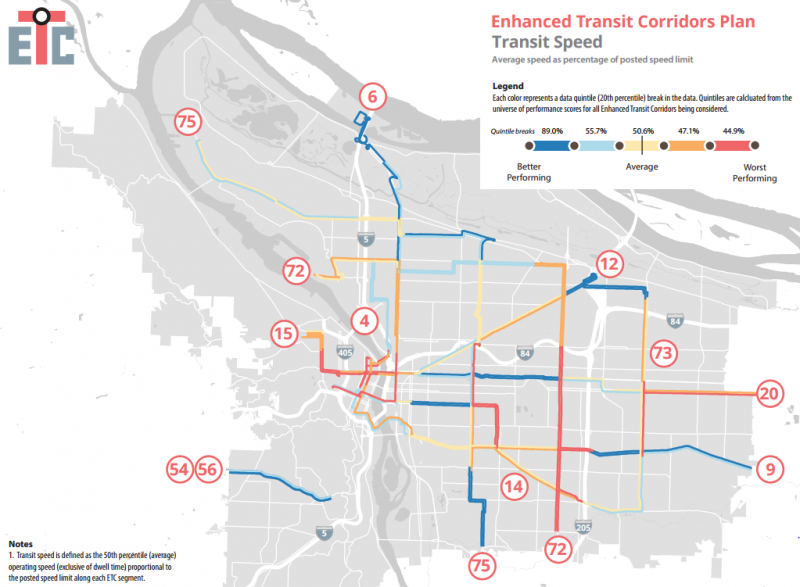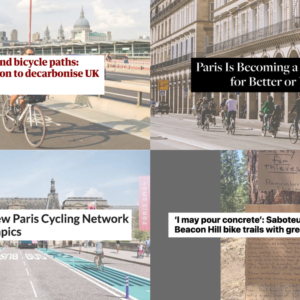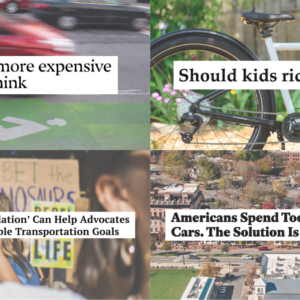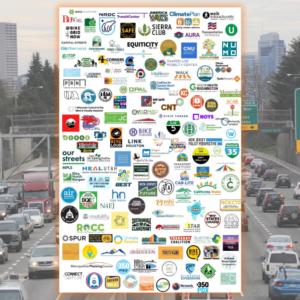
If we don’t want these additional buses stuck in the same traffic, we need to provide dedicated space on our streets for them.
This post was written by Luke Norman, a BP subscriber and volunteer with Portland Bus Lane Project.
The Portland Bureau of Transportation’s Growing Transit Communities Plan is slated for a hearing (and possible adoption) on September 6th. Now is the time to learn about it and consider sharing your feedback.
The plan is primarily focused on improving access to TriMet bus lines 20, 77, & 87, which include some great safety and connectivity projects for people walking and biking. However, hidden in the document are two corridor studies that have the potential to significantly increase transit connections for East Portland residents.
The Outer Stark Corridor Plan will study the potential of providing bus lanes and safety improvements on SE Stark east of Gateway to Portland’s city limits at SE 162nd Ave.
Over 10,000 residents who live along the Outer Stark corridor commute across our region for work. And many of them take Line 20, with the busiest stops serving over 800 riders daily.
Unfortunately for residents who rely on Line 20, the Outer Stark segment is one of the most delayed transit corridors in Portland:
For perspective, here’s what SE Stark at 162nd Ave (facing west) looks like today:

And here’s what it could like if the Outer Stark Corridor Plan was funded and implemented, so people biking and taking the bus were prioritized:

The second important corridor study is the Airport Way & I-205 Transit Study. NE Airport Way plays an important role in Portland’s economy as it is home to over 20,000 jobs. However, transit isn’t a reliable option for workers as traffic merging onto I-205 regularly backs up to NE 122nd.
For perspective here’s what Airport Way at 122nd Ave (facing west) looks like today:

The Airport Way & I-205 Transit Study would evaluate providing a center bus lane, so buses headed west can make a left turn to access Gateway Transit Center at NE Holman St.
Here’s what it could like if that study was funded and implemented so people biking and taking the bus were prioritized:

An additional reason these studies are important is that TriMet considering increasing the service on Line 20 & Line 87 to frequent service status.


If we don’t want these additional buses stuck in the same traffic, we need to provide dedicated space on our streets for them. Asking City Council to fully fund these studies is an important first step in making that happen.
City Council will be holding a hearing on the Growing Transit Communities Plan at 10:00 am (time certain) on September 6 in the Council Chambers at 1121 SW 4th Ave.
For more information on the Portland Bus Lane Project visit: https://portlandb.us.
— Luke Norman
Never miss a story. Sign-up for the daily BP Headlines email.
BikePortland needs your support.






Thanks for reading.
BikePortland has served this community with independent community journalism since 2005. We rely on subscriptions from readers like you to survive. Your financial support is vital in keeping this valuable resource alive and well.
Please subscribe today to strengthen and expand our work.
The Vancouver traffic backups in the afternoon can be a major problem for transit in the city. The 12 and 21 often get stuck in the Parkrose area. It is extremely frustrating as a ride to be about a mile from your MAX transfer, knowing that it will take 10-15 minutes to get there. On several occasions, I have gotten off the bus and walked the last mile in order to make the transfer. More dedicated lanes are needed.
As a TriMet operator, I can attest to the shameful lack of priority or dedicated ROW. If we want people to actively choose transit/bike we need to provide them with a real benefit over driving.
Transit use has dropped or remained steady every year for the last ten in Portland despite over 90,000 new residents.
The reasons why are clear:
1) it takes forever to get anywhere on a bus due to low headings/hr and congestion.
2) the on-board experience is dreadful. No policing or enforcement of disruptive behavior and the ride quality is rough and loud.
3) buses on frequent service get stuck and bunched up leading to terrible delays when people need us most.
Add it all up, and it’s just a loosing proposition for most people who have any choice in the matter.
Humble suggestions: eliminate one lane of on-street parking in areas of congestion: Burnside on both sides of the river from SW 5th Ave to SE 16th, Sandy outbound from 42nd to 82nd, both sides on Belmont Division and Hawthorne from 39th to 11th. Burnside bridge dedicated outbound HOV lane. Hawthorne convert outer travel lanes to bus only.
Long-term: build additional local bridge paralleling Hawthorne and build dedicated transit-only bridge near Steel. What annoys me is that we desperately needed another bridge and they gave us the Tillicum crossing. The right bridge in precisely the wrong place It’s only able to serve 2 bus lines because of the way it was designed and sited.
MLK!
One of the drawbacks of parking removal is that it widens the feel of the street and encouraged speeding during lower-congestion periods. A good compromise is to have time-restricted bus lanes. From 7am to 7pm, these lanes are bus-only, and can be used for parking during the night.
That’s a good idea (and one they use in Melbourne, AU), however, the city has to commit to towing away cars that are parked there between those hours. Simply ticketing an illegally parked car won’t work. The first time I encountered a peak hour no standing zone in Melbourne, I was unfamiliar with the signage and went into a store to ask about it. The proprietor told me that it was a peak hour no standing zone and that if I didn’t immediately move my car, the city would tow it – no ifs, ands or buts.
Politics……
Given this awful and tragic record it is interesting that PBOT decided to eviscerate bike mode share goals (despite a 120% increase in mode share over 10 years) and suggest that transit mode share would take up the slack.
Was this on our (PBLP’s) radar? Thank you, Chris, I think it is now.
But bus 56 need a reroute connecting farm land UGB to Sylvan and Washington Park.
I remember getting on 87 in front of Goodwill and it taking something like 20 minutes to get to Burger King.
The observed average speed on SE Stark near Portland Nursery is 45-50mph in a 25 MPH zone. It’s still a speeding free for all on many streets in Portland.